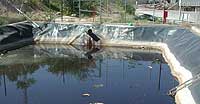Dec 23 2008
Researchers from the Jaume I University in Castellón have produced an Environmental Risk Index relating to ponds containing lixiviates, polluting liquids from tips or composting plants, which are near river courses. The aim of the study is to quantify their environmental risk and protect surrounding areas.
 Pond at a waste dump. Photo: SINC / Francisco J. Colomer
Pond at a waste dump. Photo: SINC / Francisco J. Colomer
In Spain, 20% of the earth or concrete ponds used to store lixiviates are close to a river. This represents a significant environmental risk if the pond is broken, becomes eroded or its contents overflow. The primary dangers from the 87 such ponds counted throughout Spain in 2006 stem from the potential spills of polluting liquids because of ponds starting to leak or their sides being broken.
Now, a research team from the Jaume I University (UJI) has published a new Environmental Risk Index in the latest edition of the magazine Waste Management, showing the risks from earth lixiviate ponds located in composting plants, dangerous waste dumps and sewage treatment stations.
“These liquids usually contain a high level of pollutants (chemical substances, heavy metals, etc.), which means that storing them always entails environmental risks since, if one of these ponds were to burst, the lixiviate would spill over the surrounding area, and this could affect sensitive environmental features and have a serious environmental impact,” Francisco J. Colomer Mendoza, lead author of the study and a researcher in the Mechanical Engineering and Construction Department of the UJI, told SINC.
The Environmental Risk Index uses quantitative indicators to evaluate the danger posed by the ponds to the environment. However, in order to measure the scale of the danger, it is necessary to “understand the safety parameters of the pond, its morphological and geometric characteristics, and the presence of environmental features in the area that would be flooded”.
Colomer says that these parameters include the possibility a pond’s banks eroding, the way in which it has been water-proofed, that security of its banks and the likelihood of overflows caused by heavy precipitation. The researcher highlights another important aspect as being “the effect of the avalanche of lixiviates if the pond were to break, with representative parameters being the form in which the liquids would flow downstream, and their contaminating power”.
The tool also makes it possible to estimate the size of the surface area that would be affected by the flood of lixiviates, and its consequences, while previous methodologies only evaluated one part of their environmental risk. The index evaluates the environmental risk without seeking historical data on accidents or conditions, which were necessary in traditional methodologies.
Practical information to avoid catastrophes
The researchers have applied their methodology to eight lixiviates ponds in the east of Spain (two composting plants, two waste dumps, one dangerous waste dump, one dump for non-dangerous industrial waste, and two urban solid waste dumps), which allowed them to determine that values below 0.025 (out of 1) imply a low environmental risk. If the pond has a higher value than this, it is outside the safety margins, which means that “its design should be modified or its location changed”.
The ponds posing the greatest environmental risk are located less than 2,000 metres from a water course. In these cases, if the ponds’ sides were broken, the lixiviates would reach the water and contaminate it. The new Index allows the staff in charge of each facility to calculate its risk factor.